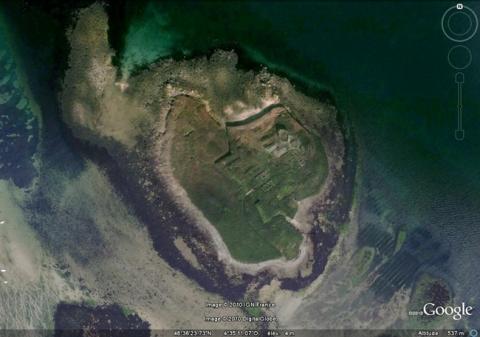Fort Cézon
History and description
The fort Cézon was constructed on the island of the same name by Vauban. It was designed to protect the entrance of Aber Wrach, a Breton bay which could have served as a port for enemy landings, in direction of Brest. It was constructed shortly after the siege of Brest by the English, one that Vauban had repelled. The site had already been marked out in 1685 and a project of four batteries had been drafted this year. Intended to shelter a harbour master, two lieutenants and ten soldiers, the project was implemented in 1694. Vauban then constructed a tower and inner fortified structure with seven embrasures, surrounded by two coastal batteries and lateral curtain walls on the land side. This curtain wall was defended by two demi-bastions and a small moat. The gate was included in this front. Within the ramparts, the complete set-up included barracks, a guardroom, food stores, powder kegs, gatehouses and a guardian’s residence. Ten years later, the engineer Robelin added a fortified front there for further reinforced protection.In 1811, the engineers abandoned the external entrenchments. In 1859, a new powder keg was constructed, protected against marine bombardments by an earth bank, and with sufficient capacity to hold ten tons of gunpowder. The fort was transformed in 1940 by the German army in order to function as a look-out and artillery post as part of the Atlantic Wall. Seventeen blockhouses were constructed and numerous trenches were dug with the same objective.
Current state
The fort Cézon still stands. Private property since 1957, it can still be visited in summer and on special occasions. The isle is accessible on foot, at low tide. The Cézon association is working on its restoration and evaluation.
Fort Cézon
Fort Cézon
48° 36' 23.5332" N, -4° 35' 10.5324" E
Type
coastal battery
Engineers
Sébastien le Prestre de Vauban, Isaac Robelin
Department
Finistère
Region
Bretagne
Bibliography
- FAUCHERRE (N.), LECUILLIER (G.), La route des fortifications en Bretagne Normandie, Paris, 2006.
- Inventaire Général de Bretagne, http://inventaire-patrimoine.region-bretagne.fr/gertrude-diffusion/dossier/fort-av-36-dit-fort-cezon/742e0d3c-ffa6-4717-b089-cd443d6c0bc9
- LEVOT (P.), Histoire de la ville et du port de Brest, Brest-Paris, 1865, p. 47-48.
